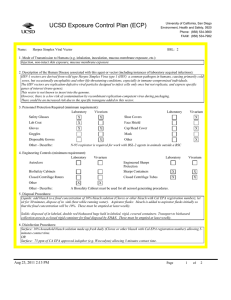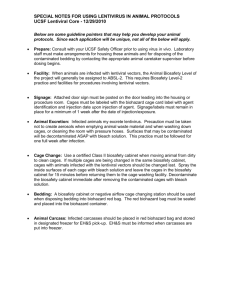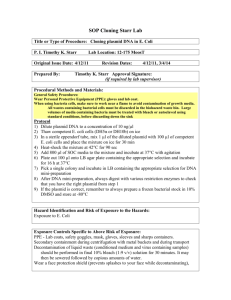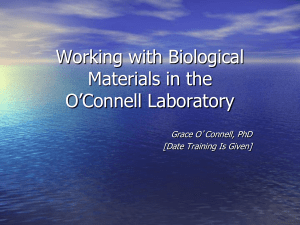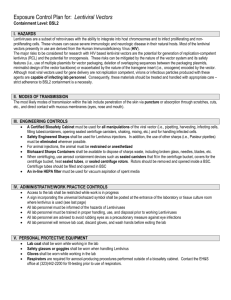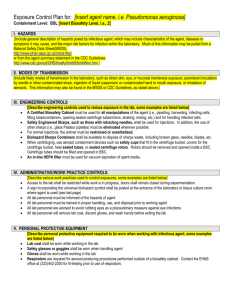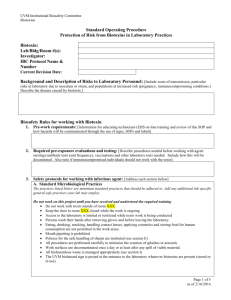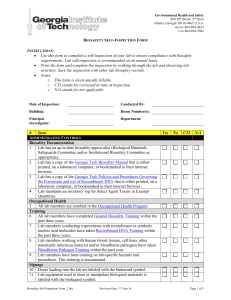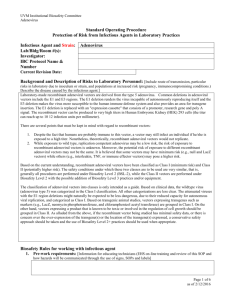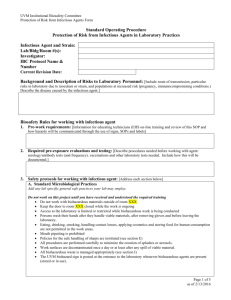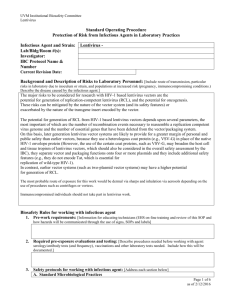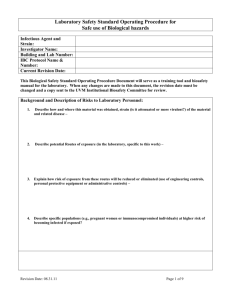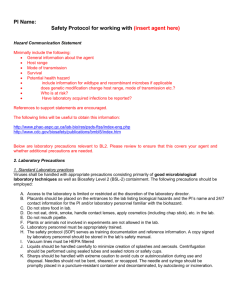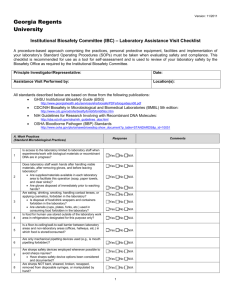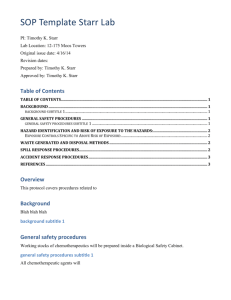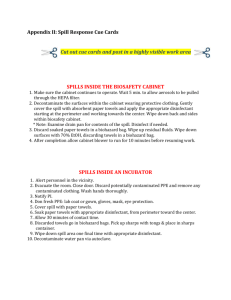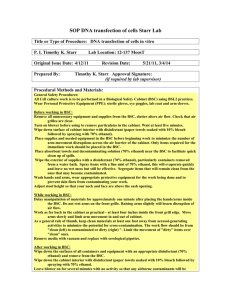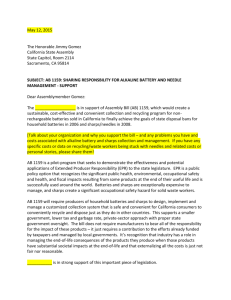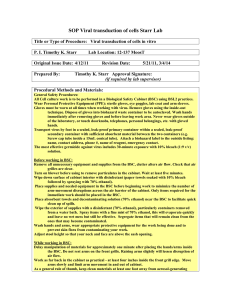Exposure Control Plan - University of Southern California
advertisement
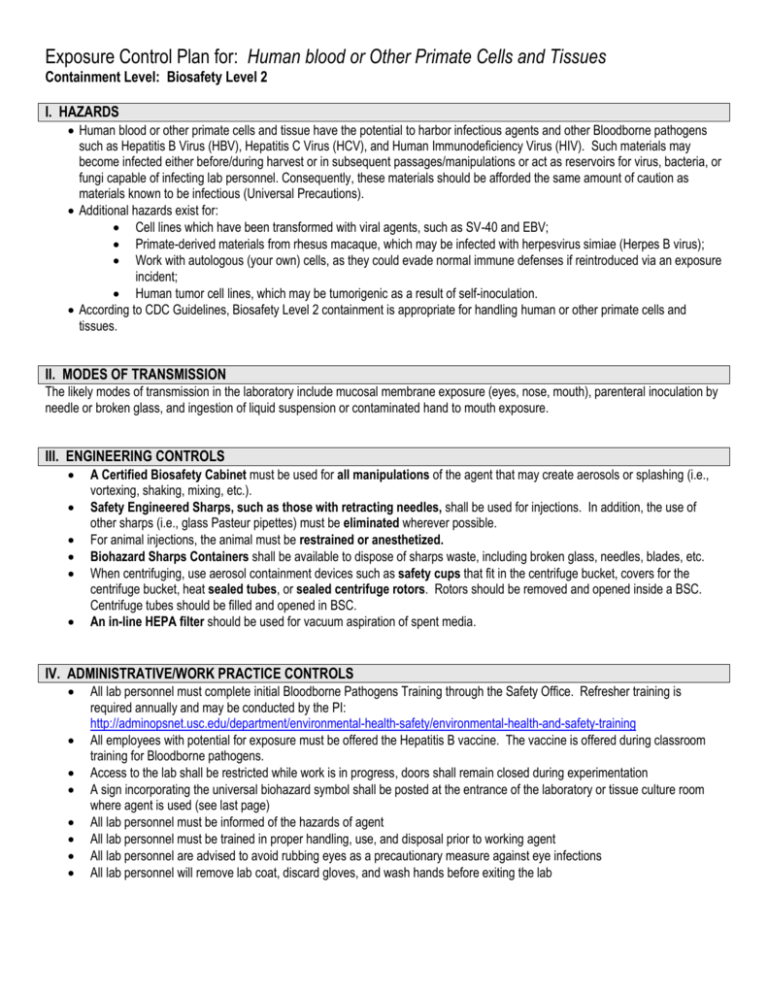
Exposure Control Plan for: Human blood or Other Primate Cells and Tissues Containment Level: Biosafety Level 2 I. HAZARDS Human blood or other primate cells and tissue have the potential to harbor infectious agents and other Bloodborne pathogens such as Hepatitis B Virus (HBV), Hepatitis C Virus (HCV), and Human Immunodeficiency Virus (HIV). Such materials may become infected either before/during harvest or in subsequent passages/manipulations or act as reservoirs for virus, bacteria, or fungi capable of infecting lab personnel. Consequently, these materials should be afforded the same amount of caution as materials known to be infectious (Universal Precautions). Additional hazards exist for: Cell lines which have been transformed with viral agents, such as SV-40 and EBV; Primate-derived materials from rhesus macaque, which may be infected with herpesvirus simiae (Herpes B virus); Work with autologous (your own) cells, as they could evade normal immune defenses if reintroduced via an exposure incident; Human tumor cell lines, which may be tumorigenic as a result of self-inoculation. According to CDC Guidelines, Biosafety Level 2 containment is appropriate for handling human or other primate cells and tissues. II. MODES OF TRANSMISSION The likely modes of transmission in the laboratory include mucosal membrane exposure (eyes, nose, mouth), parenteral inoculation by needle or broken glass, and ingestion of liquid suspension or contaminated hand to mouth exposure. III. ENGINEERING CONTROLS A Certified Biosafety Cabinet must be used for all manipulations of the agent that may create aerosols or splashing (i.e., vortexing, shaking, mixing, etc.). Safety Engineered Sharps, such as those with retracting needles, shall be used for injections. In addition, the use of other sharps (i.e., glass Pasteur pipettes) must be eliminated wherever possible. For animal injections, the animal must be restrained or anesthetized. Biohazard Sharps Containers shall be available to dispose of sharps waste, including broken glass, needles, blades, etc. When centrifuging, use aerosol containment devices such as safety cups that fit in the centrifuge bucket, covers for the centrifuge bucket, heat sealed tubes, or sealed centrifuge rotors. Rotors should be removed and opened inside a BSC. Centrifuge tubes should be filled and opened in BSC. An in-line HEPA filter should be used for vacuum aspiration of spent media. IV. ADMINISTRATIVE/WORK PRACTICE CONTROLS All lab personnel must complete initial Bloodborne Pathogens Training through the Safety Office. Refresher training is required annually and may be conducted by the PI: http://adminopsnet.usc.edu/department/environmental-health-safety/environmental-health-and-safety-training All employees with potential for exposure must be offered the Hepatitis B vaccine. The vaccine is offered during classroom training for Bloodborne pathogens. Access to the lab shall be restricted while work is in progress, doors shall remain closed during experimentation A sign incorporating the universal biohazard symbol shall be posted at the entrance of the laboratory or tissue culture room where agent is used (see last page) All lab personnel must be informed of the hazards of agent All lab personnel must be trained in proper handling, use, and disposal prior to working agent All lab personnel are advised to avoid rubbing eyes as a precautionary measure against eye infections All lab personnel will remove lab coat, discard gloves, and wash hands before exiting the lab V. PERSONAL PROTECTIVE EQUIPMENT Lab coat shall be worn while working in the lab Safety glasses or goggles shall be worn when handling agent Gloves shall be worn while working in the lab Respirators may be required for aerosol-producing procedures performed outside of a biosafety cabinet. Contact the EH&S office at (323)442-2200 for fit-testing prior to use of respirators. VI. DISINFECTION General surface disinfection with freshly prepared 10% bleach (1:10 dilution household bleach, such as clorox) allowing a contact time of 15 minutes. For stainless steel surfaces, follow bleach disinfection with 70% ethanol wipedown to avoid corrosion. Liquid waste may be treated by exposing to bleach (final volume 10%) for 15 minutes before disposing into sink. VII. DISPOSAL Solid biohazardous waste, such as culture vials, plates, plastic tubes, etc., are disposed of into biohazard waste bins lined with red bags for pickup by EH&S. Biohazard bins are labeled with biohazard stickers, and lids are to remain secured when not in use. Sharps waste, such as broken glass, pasteur pipets, razor blades, and needles, are disposed of into biohazard sharps containers. When the fill line on the sharps container is reached, the lid will be secured and the container placed next to the biohazard bin for pickup by EH&S. To request a pickup, call the EH&S waste disposal line at (323)442-2225. VIII. ACCIDENTAL SPILL In case of spill inside of biosafety cabinet: Lower sash and let biosafety cabinet continue to run (at least 5 minutes) in order to contain aerosols Immediately notify others around you Contaminated personal protective equipment(PPE), such as gloves, labcoat, and safety glasses, should be removed and disposed of as biohazardous waste or set aside for disinfection For exposures/contamination, see “Personnel Contamination/Exposure Response” guidelines below Don appropriate PPE if not already wearing Use forceps to remove any broken glass or other sharp items; sharps must be placed into biohazard sharps containers Cover the spill with paper towels or other absorbent materials Apply 10% bleach directly around and onto the paper towels covering the spill Allow 15 minute contact time before cleaning, starting at the perimeter and working inwards towards the center Dispose of materials into biohazard bins Disinfect all surfaces of the biosafety cabinet with freshly prepared 10% bleach with a 15 minute contact time, followed by a wipedown with 70% ethanol to reduce corrosion Allow biosafety cabinet to run for at least 10 minutes before resuming work or turning off For large spills, you may contact the EH&S office for assistance at (323)442-2200 In case of spill in lab (outside of biosafety cabinet): Immediately notify others around you Contaminated personal protective equipment(PPE), such as gloves, labcoat, and safety glasses, should be removed and disposed of as biohazardous waste or set aside for disinfection For exposures/contamination, see “Personnel Contamination/Exposure Response” guidelines below Leave the room and restrict access for 30 minutes to allow aerosols to settle Enter room wearing appropriate PPE Use forceps to remove any broken glass or other sharp items; sharps must be placed into biohazard sharps containers Cover the spill with paper towels or other absorbent materials Apply 10% bleach directly around and onto the paper towels covering the spill Allow 15 minute contact time before cleaning, starting at the perimeter and working inwards towards the center Dispose of materials into biohazard bins For large spills, you may contact the EH&S office for assistance at (323)442-2200 Revised 11/5/13 IX. EXPOSURE RESPONSE In the event of an exposure, take the following precautions: Remove any contaminated clothing Wash all affected areas; for eye exposures, rinse for 15 minutes in eyewash or flush area with water, for needle-stick or other sharps exposure, wash wound area with soap and water for 15 minutes Report the exposure to your supervisor immediately For students, seek treatment at one of the following locations: Health Science Campus (HSC): University Park Campus (UPC): Eric Cohen Student Health Center USC Engemann Student Health Center Healthcare Consultation Center (HCC) 1031 West 34th St. 1510 San Pablo St., Suite 104 Los Angeles, CA, 90089-0311 (323)442-5631 (213)740-8742 For employees, seek treatment at one of the following locations: Health Science Campus (HSC): University Park Campus (UPC): Internal Medicine USC Engemann Student Health Center Healthcare Consultation Center II (HCC II) 1031 West 34th St. 1520 San Pablo St. Los Angeles, CA, 90089-0311 (323)442-5100 (213)740-8742 Or Or White Memorial Medical Center(24hr emergency) Good Samaritan Hospital(24hr emergency) 1720 Cesar E. Chavez Ave. 1225 Wilshire Blvd. Los Angeles, CA 90033 Los angeles, CA 90017 (323)268-5000 (213)977-2121 For any emergency, you may also contact the Department of Public Safety at (323) 442-1000(HSC) or (213)740-4321(UPC) Healthcare personnel treating exposed patients should be informed of the nature of the agent (i.e., human or primate derived materials, potential for exposure to bloodborne pathogens) Information on workers’ compensation can be found at this website: http://benefits.usc.edu/timeoff/workers-comp/ or you may call: (213)740-6205 Incidents should be reported to the Institutional Biosafety Committee as soon as possible: IBC@caps.usc.edu or (323)4422200 Revised 11/5/13 AUTHORIZED PERSONNEL ONLY WHEN WORK WITH INFECTIOUS AGENTS IN PROGRESS University of Southern California Laboratory Safety (323) 442-2200 BIOSAFETY PRECAUTIONS Building: Room Number: Identification of Hazard(s): Human/Nonhuman Primate Cells/Cell Lines Biosafety Level: 2 Principal Investigator: Emergency Contact Person: Department: Phone: Phone IBC Protocol#: Date: Basic Personal Protective Equipment required when working with agent: 1. Lab Coat 2. Gloves 3. Safety Glasses 4. Closed-toe shoes Authorized Personnel: Revised 11/5/13
